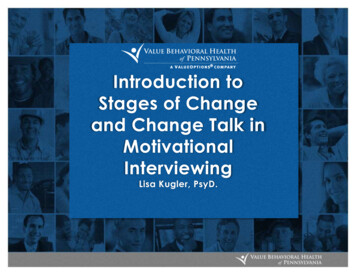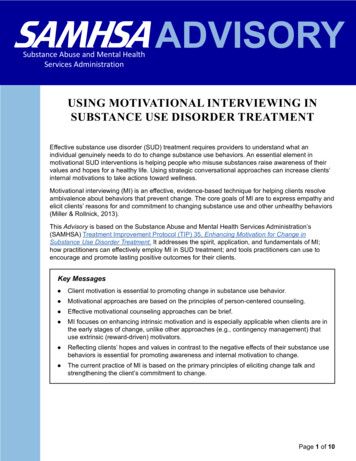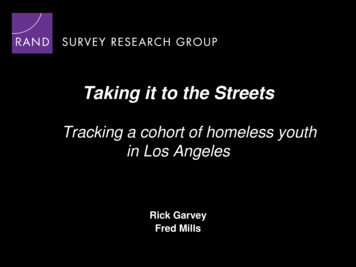
Transcription
MOTIVATIONAL INTERVIEWING:A brief guideGary LatchfordAlistair DuffDepartment of Clinical and Health PsychologySt James’s’ University HospitalLeeds
About this GuideKeeping well in CF depends crucially, of course, on an individuals’adherence. No matter how effective a treatment, if a patient orfamily struggles to adhere they will not receive the full benefit. It’simportant for us to realise that even though we may get to knowour patients well, the main job of managing CF takes place awayfrom our clinics and hospitals. The time we have with our patients,then, is an opportunity to influence how they manage outside ofthe clinic. Although it can be frustrating to work with someone whois struggling and feels difficult to influence, if we use our timewisely it is possible to make a real difference.Contents Adherence Information exchange Motivational interviewing: This guide looks at ways of making good use of this time.Motivational Interviewing (MI) is a therapeutic strategy forfacilitating behaviour change. This approach has built up a solidevidence base for effectiveness, and has been applied to a varietyof people with different problems, including adherence. We feelthat MI may offer some useful resources for busy CF clinicians.theories and principlesAbout the authorsHow to do MotivationalDr Gary LatchfordInterviewing Using MI in practice Developing and maintaining MIskills Does Mi work? Further readingGary Latchford received a PhD from the University of Edinburgh in 1989 wherehe studied under Professor Colwyn Trevarthen, and completed clinical training inLeeds in 1991, since which he has worked with people with chronic illness,particularly CF, Renal Failure and Diabetes. He is currently Research Director forthe Doctor of Clinical Psychology programme at the University of Leeds andconsultant clinical psychologist at the Leeds teaching hospitals NHS trust. Hisclinical and research interests are around coping with chronic illness, the use ofMI in physical health settings and the process of change in psychotherapy. He haspublished several book chapters and peer reviewed articles, and is an accreditedtrainer in Motivational Interviewing and Client Directed Outcome InformedPsychotherapy.Dr Alistair DuffAlistair Duff qualified as a clinical psychologist from Leeds University in 1994 andshortly after moved to St James’s University Hospital to work with children andfamilies living with chronic conditions, namely cystic fibrosis, asthma, renaldisease and diabetes. From 1997, he specialised exclusively in CF and respiratorydisease, developing a specialist interest in adherence to treatment, proceduraldistress, neonatal screening and transplantation. He has published severalarticles on these issues and is engaged in further research. He became Head ofPsychology Services for Leeds Teaching Hospitals in 2007 and was awarded anHonorary Senior Lectureship at the University of Leeds. He continues to beactively involved in supervision, teaching and training, and research.MI: a brief guide
AdherenceHealth professionals are often very worried forthose under their care who are not adhering;concerned for the risks they are taking and oftenfeeling responsible for not being able to help. Whydo some people struggle so much with adherence?Actually, a better question might be ‘why do somany people not struggle with adherence?’ Afterall, many healthy behaviours such as dentalflossing or avoiding fatty foods are much lessdifficult to adhere to than the treatment regimenin CF and yet so many in the general populationstruggle with them.Our starting point, then, is that adherence in CF can be tricky. This doesn’t mean that we accept it if peopledon’t adhere without trying to intervene, but it does mean that if we are to stand a chance of influencingpeople so that they have better adherence we need to know what’s going on.We know that adherence in a whole variety of medical conditions is poor (time and again research has indicatedthat 30–50% of patients with chronic conditions do not take their medicines as directed) and this includes CF. Itdoes depend a little on how we define adherence – for example keeping to all the treatment recommendationsevery day without fail versus having some fully adherent days and other poorly adherent days. Patterns of nonadherence can actually have important effects. In general, most people with chronic conditions that require anactive treatment regimen are only partially adherent, and CF is no different.So what affects rates of adherence, and what can be done about different causes? We suggest a generalframework below, but it is inevitably crude compared to the complexities of the individual - in reality there is, ofcourse, no substitute for talking to someone to find out their own individual circumstances.MI: a brief guide
Potential problemsLack of knowledgeSometimes people are genuinely unsure about what they need to do. Although it may have been explained inthe past, it’s wise not to assume that this necessarily means that the information has been understood.Research has clearly shown that there are helpful and unhelpful ways of conveying information – informationexchange would be a good way of giving someone information tailored to their situation - more on this below.Remember, too, that there are many reasons that people may not ask for clarification – they may not realisethat they have misunderstood, or may be too embarrassed or shy to ask, for example.Problems putting adherence information into practice.Sometimes a patient may agree on the need to improve adherence but not be sure how to make changes inpractice. They need to find a way to incorporate treatment into their daily routines, and find ways aroundpossible barriers. Problem solving approaches may be ideal in helping someone find a solution.Problems taking on board the importance of adherenceSometimes a patient may not appear to be aware of the importance of improving adherence. Occasionally thismay be lack of knowledge but is often more complex - you may find that just providing information has little orno effect. Instead, many patients find themselves in the situation in which they have poor adherence and whenthey think about this it generates such anxiety that they try not to think about it, which means in turn thatchange becomes unlikely. This vicious circle can continue for years, and poor adherence behaviours becomepart of a daily routine. In such situations the best way forward is to engage the patient in a conversation aboutthis, and to help them consider their options (to change or stay the same). Motivational interviewing is a goodway to do this, and ensures that thoughts about changing and improving adherence become a central part ofthe conversation.Deliberately choosing not to adhere.Some patients may make a decision not to adhere, in order to enjoy life in the here and now. Whilst we alwayshave to respect the right of every patient to make their own decisions about their life and their treatment, wealso ought to be mindful that it is important that this is an informed decision and that the patient has freelychosen, rather than, for example, felt so afraid of their CF that it has been easier to choose to ignore it.Sometimes people see non-adherence as a way of “not letting CF beat me”, seeing non-adherence as a way ofleading a ‘normal life’. Again, MI is a good way to have a conversation about this, and revisit this decision,considering good adherence as an alternative way of minimizing the intrusions of CF into life, and taking controlof it.MI: a brief guide
Tackling adherence and the importance of collaborationHopefully by now we’ve conveyed the key principle that changing behaviour is tricky for most of us, even whenwe know, deep down, that we should do it. Ironically, this is especially true if we have potentially strong feelingsabout it or the stakes are high – the many dangers of smoking are well known but smokers are ingenious in theways they can ignore worrying information about it and justify carrying on. Similarly, adherence in CF isobviously a major worry for the patient and family. In order to help, then, you have to build up a relationship oftrust. If you haven’t got this, then someone is unlikely to be honest with you if they are struggling. Instead, it’slikely that they will tell you what they think you want to hear.A good way to think about this is that you develop collaboration with your patient. This doesn’t mean that thetwo sides in the relationship are the same – you will have specialist knowledge that may be of vital use to yourpatient, your patient will have knowledge of what it’s like trying to adhere in the real world outside of the clinic.what it does mean is that you trust each other to be open about what’s going well and what’s not, and that youagree to work together to solve any problems that arise. Your goals are clear and there is nothing wrong withbeing upfront about them - you want good adherence and for your patient to be medically stable. You need tobe mindful that your patient may not be on the same page, however, and patient in your attempts to help themresolve the problems holding them back.Giving information: a guide to information exchangeAs we have argued above, sometimes poor adherence is a function of simply being unsure what to do. It is easyto underestimate the skill required in conveying complex information, and the barriers to someone taking onwhat is required of them.There are many occasions when you may need to give information to a patient. Sometimes you may discoverthat it is lack of information – or a misunderstanding – that is contributing to poor adherence. The temptation isthen to put this right by giving out all the information you think they might need. The problem here is that thiscan sometimes not work if the person isn’t ready to receive the information and is overloaded by it. They simplywon’t be able to recall what you’ve said afterwards.Think about your favourite novel, perhaps one you read many years ago. Did you have any trouble finishing it?Could you tell someone what it was about? Now think about a book you were told to read at school but didn’tenjoy. Was it easy to read or did you find it hard going? Could you explain what it was about? The difference isthat you were engaged with the first book – you were interested in it and thinking about it, so you rememberedit!MI: a brief guide
The elicit-provide-elicit cycleThe key when presenting information, then, is to engage the person first. The simplest way of doing this is toask them what they already know about the topic first (elicit). This helps you shape up the information you areto present, and also starts the person thinking about it. You then need to present the information (provide).Following this, you need to check that they have understood what you have said by asking them (elicit). Thereare many reasons why they may not tell you if they haven’t – they may wrongly believe they have understood,or they may be too embarrassed to admit that they haven’t heard.So, the routine to adopt when giving any piece of information is to:1. Understand what the patient already knows, and what they would like to know, by asking.2. Provide information in as neutral a way as possible.3. Check their understanding of what you have just said - “what do you make of that information?”In this way the patient is engaged in the process before you give the information. They are therefore more likelyto think about the meaning of what you say, process it, and integrate it with their own experience and beliefs.Personal integration is always best done by the patient.Sometimes the questions you ask after you have presented information can really aid this process, such as: “What do you make of that?”“So, where does that leave you?”“What would you like to do next?”There are some other general rules for giving information.The most important is to always ask permission first. If you do not, it could feel like a lecture and the patientmay not be receptive, even if you are presenting useful information.This can be done quickly, simply by saying:“Is it OK if I tell you a little more about that?”MI: a brief guide
There are other helpful guidelines for presenting information. If you are saying a lot, be careful to break upinformation into manageable chunks. You need to watch the pace as you present it, and don’t be afraid to keep“checking in”, to make sure the other person is listening and understanding.Another useful strategy is to find opportunities for small summaries of what you’ve said so far, or reflections onit, from yourself or the patient. And don’t forget the importance of affirmation: if it is a lot of information,reflect this:“I guess this might be a lot to take in”We also know that other factors can influence how much information people can remember. In particular, ifpeople are anxious they usually do not remember what they are told at the time. You may need to repeatinformation several times. On such occasions it is important to break larger pieces of information down, and ifat all possible give written material too.Remember that some information is easier to understand than others. Remember, too, that if someone asks forinformation they may actually be indicating a need to talk and for emotional support, rather than justinformation.Lastly, the words you use are, as ever, extremely important and can convey your feelings about the situation.They can influence the consultation to be a useful and receptive one, or am unhelpful and potentiallyantagonistic one.For example, avoid using “I” or “you”. In particular, don’t say:“I want you to do ” Or “You should do ”Remember, someone will change if they want to do it, not if you want them to do itInstead, use more neutral language wherever possible:“You might consider ” or “we could do it this way ”And if you want to pass on an opinion, a more effective way might be to say:“Other people have found that ”MI: a brief guide
Motivational Interviewing: principles and practiceMotivational interviewing is an intervention designed for situations in which a patient needs to make abehaviour change but is unsure about it, sometimes to the extent of being quite hostile to the idea. It builds onthe idea that the first step in any consultation is actually to get a conversation going. It then uses particularstrategies to focus this conversation on behaviour change, and to ensure that the patient is helped to considerchange as an option.The background to MI lies in the treatment of people with alcohol problems. The traditional approach had beento confront the person with their drink problem, the belief being that unless they admitted they had a problem,they would never get better.When this was done, however, people who were being confronted fought back by denying they had a problem.This shouldn’t really be a surprise. It’s not an easy thing to hear yourself being called an alcoholic who hasruined their life, and many responded by not hearing it, and coming up with reasons why their counsellor waswrong (“I don’t drink any more than the next guy ”). It was tempting for those providing counselling to thenblame the patient, seeing them as having “no will power” and “no motivation”.The first paper on MI, written by a psychologist in New Mexico called Bill Miller in 1983, tackled this issue, andwas rooted in his own clinical practice – basically he reflected on his own clinical work with his students andcame up with an alternative viewpoint. In contrast to the prevailing view, he suggested that rather than seeingdenial as poor willpower or lack of motivation to solve the problem, it might be more helpful to see thisoutcome as a product of the situation in the counselling session. Basically, when we confront anyone withsomething, we are likely to increase their resistance and hear them argue the opposite side.Bill Miller went on to suggest a number of ways that a counsellor might try and avoid a confrontation, and thislaid the foundations of MI. These idea started to circulate, and came to the attention of Stephen Rollnick, aclinical psychologist originally from South Africa but then working in Addictions in the UK, who saw therelevance of this approach to physical health settings, especially adherence. They went on to collaborate on thefirst book on MI, and many publications since.A commonly used definition of MI is:‘A directive, patient-centered counseling style for eliciting behaviour change by helping patients toexplore and resolve ambivalence.’ (Rollnick and Miller, 1995)It sometimes seems strange to see MI described as both person centred and directive, since person centredapproaches are traditionally not directive at all. Its’ a good description, though, as the aim of the intervention into encourage the patient to change their behavior.MI: a brief guide
The theory and main principles of Motivational InterviewingAlthough MI clearly has its roots in clinical practice, it isnow clear that the principles behind MI – why it workshave a very long history in terms of theory.They can be briefly summarised as six general principles:Principle 1: don’t tell people what to do because it usually doesn't work, even if you’re right.Basically, if people don’t feel they have a choice, they feela real need to do whatever it is they’ve been told not to- to prove they still have free will. It can be summarisedin the phrase “No one tells me what to do” and seen in its purest form in most teenagers! This was the basis ofReactance Theory by Jack Brehm in 1966.Principle 2: listenIf you can’t listen and engage someone in conversation, they are never going to change. This part of MI has itsroots in patient centered counseling, proposed by Carl Rogers in 1951, who argued that change can befacilitated by providing someone with a therapist who adopts a non-directive style, who is empathic, genuine intheir attempts to understand, warm in their responses but who mostly listens. If someone is expecting to bepersuaded or told off about not adhering, this is unexpected!Principle 3: let the patient tell you they need to changeThe very best thing that can happen is for someone to tell you why they should change. If someone says itthemselves without you saying it first, it’s much more powerful. Basically, ‘People believe what they hearthemselves say’. Also, the reasons tend to be more powerful too – if you do something because you think it isright you are more likely to carry through than if you are doing it because you are trying to please someone (likeyour mom or your doctor!).This was investigated scientifically by Daryl Bem in 1966 but actually goes back much further – to 1670 and theFrench mathematician and philosopher Blaise Pascal who noted that people are much better persuaded byreasons they think up themselves than those thought up by others. People are very good at convincingthemselves, but alert to other people trying to do the convincing. No doubt advertisers have a pretty goodunderstanding of this, which is why modern adverts are much more subtle!MI: a brief guide
Principal 4: cognitive dissonanceThis was cited by Bill Miller in his first paper. He’s not sokeen on this now, but we rather like it. Basically, Cognitivedissonance was proposed by Leon Festinger to be a feature ofsituations in which people are struggling with a choice aboutchanging which is making them feel uncomfortable – such aswhen there is something someone feels they ought to do butthey are not doing it (such as filling out a tax return, giving upsmoking, taking medication). This conflict itself makes peopleuncomfortable and produces a momentum towards changeif handled in the right way.CognitiveCognitive dissonancedissonanceII seesee myselfmyselfsmokesmokeII thinkthink I’mI’msensiblesensibleIncompatableIncompatable beliefsbeliefs DD ii ss ss oo nn aa nn cc eeSolution?Solution?II needneed toto quitquitItIt won’twon’t dodo meme anyany harmharmCognitive dissonance is a very powerful phenomenon that every one of us has experience of. MI refers to thisand aims to use an understanding of the principles to encourage change. Basically, if the contrast between thetwo choices is brought out, people feel an urge to resolve the conflict by choosing. With your help, they canchoose to change.Principle 5: people need to feel confident before trying to changeEven if someone is convinced of the need to change, if they don’t feel confident they are unlikely to try. Worse,they can feel depressed since they realize their predicament. Albert Bandura captured this with the idea of selfefficacy (self belief). If this is high, someone will feel confident and are much more likely to succeed. Mi isexplicit about the need to keep morale high.Principle 6: is ambivalence is normalIt’s normal for human beings to be unsure about what to do, especially if the choice is tough, or involves achange which would be difficult.MI: a brief guide
How to do Motivational Interviewing“Motivational interviewing has been practical in focus. Thestrategies of motivational interviewing are more persuasivethan coercive, more supportive than argumentative. Themotivational interviewer must proceed with a strong senseof purpose, clear strategies and skills for pursuing thatpurpose, and a sense of timing to intervene in particularways at incisive moments” (Miller and Rollnick, 1991, pp.51-52).The four principle strategies of MI are:A practitioner using MI will be able to: 1. Get a conversation going - express empathy throughreflective listening.2. Develop discrepancy between a patients' goals or valuesand their current behavior.3. Avoid argument and direct confrontation and adjust toresistance rather than opposing it directly.4. Support self-efficacy and optimism. Clinicians who adopt motivational interviewing as a preferred stylehave found that the following five strategies are particularly usefulin the early stages of treatment:1. Ask open-ended questions. Open-ended questions cannot beanswered with a single word or phrase. For example, ratherthan asking, "Do you like to drink?" ask, "What are some ofthe things that you like about drinking?"2. Listen reflectively. Demonstrate that you have heard andunderstood the patient by reflecting what the patient said.3. Summarize. It is useful to summarize periodically what hastranspired up to that point in a counselling session.4. Affirm. Support and comment on the patient's strengths,motivation, intentions, and progress.5. Elicit self-motivational statements. Have the patient voicepersonal concerns and intentions, rather than try topersuade the patient that change is necessary.In using MI in practice, you initial goal is to engage the patient inconversation. Without this, of course, nothing will happen.MI: a brief guide Express empathy throughreflective listening.Communicate respect for andacceptance of patients and theirfeelings.Establish a non-judgmental,collaborative relationship.Be a supportive andknowledgeable consultant.Compliment rather thandenigrate.Listen rather than tell.Gently persuade, with theunderstanding that change is upto the patient.Provide support throughout theprocess of recovery.Develop discrepancy betweenpatients' goals or values andcurrent behavior, helpingpatients recognize thediscrepancies between wherethey are and where they hope tobe.Avoid argument and directconfrontation, which candegenerate into a powerstruggle.Adjust to, rather than oppose,patient resistance.Support self-efficacy andoptimism: that is, focus onpatients' strengths to support thehope and optimism needed tomake change.
Expressing empathy and getting a conversation startedThe first aim when working with someone is to get the conversation going. If you are concerned aboutsomeone, if it is urgent that they change a behavior, if you have many things to tell them, all of this may makeyou feel that you cannot waist time in addressing these things, but will count for nothing if they do not listen. Itdoesn’t matter if a service has access to the best medical treatments in the world; if the patient never comesback they won’t be of any help. You may feel under tremendous pressure of time – you are aware of the thingsyou need to say, and how little time you have. This is a difficult situation, but most times it’s still moreimportant to engage with the patient so that they are more likely to respond to what you are saying and comeback, rather than go through a list of things you need to say.Conversations may be thought of as operating on two levels. On the first, or surface level, we never get pastpolite, formal or stunted interactions. At this level you may ask how someone is to be told they are alright,even when the truth is very different. On the second, deeper level, we tell others what we really think and feel.The second level typifies the conversations we have with people close to us, who we trust. The first leveltypifies most consultations that occur in clinic. The problem is, if there is a significant issue preventingadherence, it will never emerge in clinic unless the conversation moves to a deeper level.We are all skilled in having conversations at a deeper level, and all have them from time to time. When inclinic, however, we usually adopt a way of interacting that keeps things as a more surface level. This is often avery good idea and keeps us focused. At times, however, we need to give ourselves permission to use some ofour natural skills in opening up a conversation with a client to the deeper level, in order to help them solve aproblem with adherence.You need to be careful that you don’t fall in to the expert trap – telling someone what you think they need todo. The danger here is that they will switch off. Instead, you need to put the patient at ease and attempt tounderstand their frame of reference, all the time encouraging a conversation about change. Let the patient domost of the talking. You are trying to foster collaboration between patient and practitioner and create aclimate for change. Don’t be afraid to acknowledge what might be on your agenda, but don’t forget to ask fortheir agenda too.You can use a number of skills to make someone feel at ease, able to open up with you, and understood if theyconfide some difficult emotions. The tools you need to use to achieve this can be remembered as the OARS: Open QuestionsAffirmationsReflective ListeningSummariesMI: a brief guide
Open questionsOpen ended questions are very useful for getting a conversation going. You probably use these a lot, and theyare great for opening up a conversation. They also prevent you from making the mistake of assuming you knowwhat’s going on for someone or how they feel. Some examples of open and closed questions are given below:Closed QuestionOpen QuestionSo you are here because you are concerned about notusing your nebuliser?Tell me, what is it that brings you here today?Do you agree that it would be a good idea for you touse your nebuliser regularly?What do you think about the possibility of using yournebuliser regularly?First, I'd like you to tell me about the medicines youtake. On a typical day, what do you take?Tell me about your nebuliser use during a typical week.Do you like to smoke?What are some of the things you like about smoking?How has your use of medicines been this week,compared to last: more, less, or about the same?What has your use of medicines been like during thepast week?How long ago did you use your nebuliser?Tell me about the last time you used your nebuliserAffirmationsThese help to keep the conversation positive. It’s important that your encouragement and support is genuine,and this can have a significant effect on the course of the conversation. One way of doing this is to makestatements of recognition of patient strengths:E.g. “not everyone manages to give up smoking as you have”MI: a brief guide
Reflective listening and summarising are the cornerstones of your techniques. They help the other person tofeel that they are being heard and open the conversations into areas necessary for change to occur.Reflective listeningReflective listening refers to reflecting back what a patient has said.Reflection can be simple and intuitive – such as reflecting back themain content of a statement (Content Reflection). This is the simplestresponse to resistance: nonresistance - repeating the patient's statementin a neutral form. It acknowledges and validates the patient’s voiceand shows you are listening. For example: Patient: This has been a rough few weeks for meInterviewer: It sounds like things aren’t going well.Reflection can also be complex and powerful, however, such as reflectingback a meaning from earlier in a conversation which has a bearing onwhat someone has just told you (Meaning Reflection). You won’t besurprised to hear that as with most skills, this get easier with practice! This is a powerful way of helpingsomeone to talk, and to think about something, such as changing their behaviour. For example: Patient: I’ve been so good at taking the medication then I got fed up and missed them all weekend.Interviewer: You feel upset because you feel as if you’ve let yourself down.Meaning reflections give you the opportunity to help move the conversation on to more meaningful topics,showing you are listening and also showing that you understand. It may seem quite a risky thing to attempt, butif said in the right way will almost always result in a deeper understanding, even if you are wrong – your patientwill tell you what is really going on!Another form of reflection is Amplified Reflection, where you exaggerate what someone has just said. This ismore risky, but very powerful when done right, and can lead to a re-appraisal by the patient.MI: a brief guide
There is another form too, which when used right can be very useful: double sided reflection. Basically, thisentails reflecting back what a patient has said but in th
published several book chapters and peer reviewed articles, and is an accredited trainer in Motivational Interviewing and Client Directed Outcome Informed Psychotherapy. Dr Alistair Duff Alistair Duff qualified as










